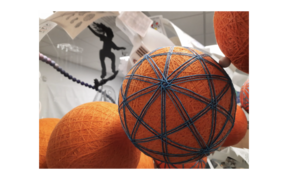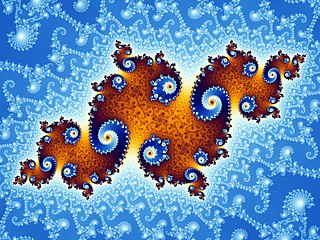
In mathematics, a fractal is a geometric shape containing detailed structure at arbitrarily small scales, usually having a fractal dimension strictly exceeding the topological dimension. Many fractals appear similar at various scales, as illustrated in successive magnifications of the Mandelbrot set. This exhibition of similar patterns at increasingly smaller scales is called self-similarity, also known as expanding symmetry or unfolding symmetry; if this replication is exactly the same at every scale, as in the Menger sponge, the shape is called affine self-similar. Fractal geometry lies within the mathematical branch of measure theory.

The Mandelbrot set is a two-dimensional set with a relatively simple definition that exhibits great complexity, especially as it is magnified. It is popular for its aesthetic appeal and fractal structures. The set is defined in the complex plane as the complex numbers for which the function does not diverge to infinity when iterated starting at , i.e., for which the sequence , , etc., remains bounded in absolute value.

Fractal art is a form of algorithmic art created by calculating fractal objects and representing the calculation results as still digital images, animations, and media. Fractal art developed from the mid-1980s onwards. It is a genre of computer art and digital art which are part of new media art. The mathematical beauty of fractals lies at the intersection of generative art and computer art. They combine to produce a type of abstract art.
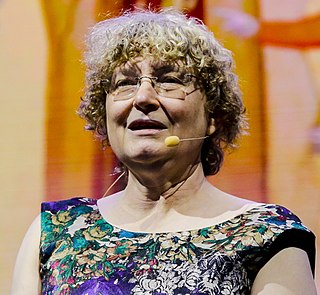
Baroness Ingrid Daubechies is a Belgian-American physicist and mathematician. She is best known for her work with wavelets in image compression.
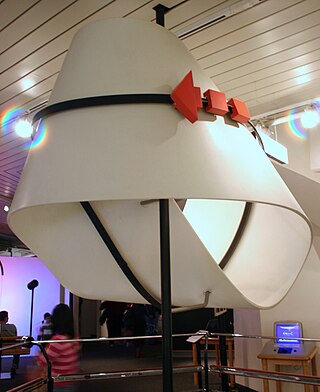
Mathematica: A World of Numbers... and Beyond is a kinetic and static exhibition of mathematical concepts designed by Charles and Ray Eames, originally debuted at the California Museum of Science and Industry in 1961. Duplicates have since been made, and they have been moved to other institutions.

George William Hart is an American sculptor and geometer. Before retiring, he was an associate professor of Electrical Engineering at Columbia University in New York City and then an interdepartmental research professor at Stony Brook University. His work includes both academic and artistic approaches to mathematics.
Jessica Katherine Sklar is a mathematician interested in abstract algebra, recreational mathematics, mathematics and art, and mathematics and popular culture. She is a professor of mathematics at Pacific Lutheran University, and former head of the mathematics department at Pacific Lutheran.

Fractal-generating software is any type of graphics software that generates images of fractals. There are many fractal generating programs available, both free and commercial. Mobile apps are available to play or tinker with fractals. Some programmers create fractal software for themselves because of the novelty and because of the challenge in understanding the related mathematics. The generation of fractals has led to some very large problems for pure mathematics.

IMAGINARY is an open platform dedicated to the communication of modern mathematics. With over 100 different exhibits, software, films, texts, and images for free use and editing, IMAGINARY connects users from over 50 countries. Science museums such as the German Museum in Munich or the Museum of Mathematics (MoMath) in New York have some of the exhibits in their collections. IMAGINARY also acted as an independent organizer of exhibitions.

Victoria "Vi" Hart is an American mathematician and YouTuber. They describe themself as a "recreational mathemusician" and are well-known for creating mathematical videos on YouTube and popularizing mathematics. Hart founded the virtual reality research group eleVR and has co-authored several research papers on computational geometry and the mathematics of paper folding.
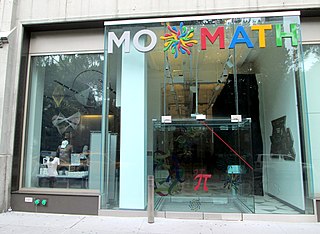
The National Museum of Mathematics or MoMath is in Manhattan, New York City, US. Opened on December 15, 2012, it was the first museum in the United States dedicated to mathematics, with over thirty interactive exhibits. The mission of the museum is to "enhance public understanding and perception of mathematics". The museum is known for a special tricycle with square wheels, which operates smoothly on a catenary surface.
This is a timeline of women in mathematics.

Nessim Sibony was a French mathematician, specializing in the theory of several complex variables and complex dynamics in higher dimension. Since 1981, he was professor at the University of Paris-Sud in Orsay.
Autumn Kent is an American mathematician specializing in topology and geometry. She is a professor of mathematics and Vilas Associate at the University of Wisconsin. She is a transgender woman and a promoter of trans rights.
Chawne Monique Kimber is an African-American mathematician and quilter, known for expressing her political activism in her quilts. She was a professor at Lafayette College, where she headed the department of mathematics. Kimber is now the Dean of the College at Washington and Lee University.
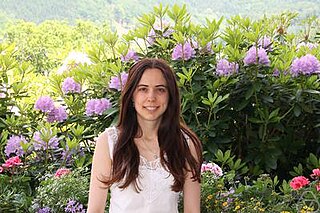
Nina Holden is a Norwegian mathematician interested in probability theory and stochastic processes, including graphons, random planar maps, the Schramm–Loewner evolution, and their applications to quantum gravity. She is a Junior Fellow at the Institute for Theoretical Studies at ETH Zurich, and has accepted a position as an associate professor at the Courant Institute of Mathematical Sciences of New York University beginning in 2021.
Carolyn Yackel is an American mathematician who has been Professor of Mathematics at Mercer University in Macon, Georgia since 2001. From 1998 to 2001 she was Max Zorn Visiting Assistant Professor of Mathematics at Indiana University.

Henry Segerman is an Associate Professor of mathematics at Oklahoma State University in Stillwater, Oklahoma who does research in three-dimensional geometry and topology, especially three-manifolds, triangulations and hyperbolic geometry.
Edmund Orme Harriss is a British mathematician, writer and artist. Since 2010 he has been at the Fulbright College of Arts & Sciences at The University of Arkansas in Fayetteville, Arkansas where he is an Assistant Professor of Arts & Sciences (ARSC) and Mathematical Sciences (MASC). He does research in the Geometry of Tilings and Patterns, a branch of Convex and Discrete Geometry. He is the discoverer of the spiral that bears his name.











